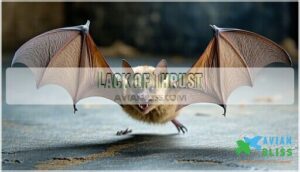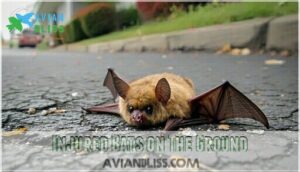This site is supported by our readers. We may earn a commission, at no cost to you, if you purchase through links.

You’ll find that their wings work more like parachutes than airplane wings, requiring them to drop from heights of 2-3 feet to generate enough lift.
Their weak leg muscles and specialized claws are built for hanging, not launching.
However, a few exceptions exist – vampire bats can actually hop and take flight from ground level, while New Zealand short-tailed bats are excellent ground walkers.
If you spot a grounded bat, it’s likely injured or exhausted.
Understanding these flight mechanics reveals fascinating survival strategies.
Table Of Contents
- Key Takeaways
- Can Bats Take Off From The Ground?
- Bat Anatomy and Physiology
- Bat Takeoff Limitations
- Exceptions: Ground-Adapted Bats
- Bat Climbing Abilities
- Injured Bats on The Ground
- Bats in Human Dwellings
- Bat Removal and Exclusion
- Frequently Asked Questions (FAQs)
- What should I do if I find a bat on the ground?
- Can bats walk on the ground?
- Can bats take off from the ground?
- Can bats take flight from the ground?
- Why are bats not able to take off if they are upright?
- Can bats fly from trees?
- Can bats take off off the ground?
- What happens if a bat lands on the ground?
- How high do bats need to be to take off?
- Can little brown bats fly from the ground?
- Conclusion
Key Takeaways
- Most bats can’t take off from flat ground because their wings work like parachutes and need a 2-3 foot drop to generate enough lift for flight.
- You’ll find that bats have weak leg muscles designed for hanging, not launching, which makes ground takeoffs extremely difficult and energy-intensive.
- If you spot a bat on the ground, it’s likely injured or exhausted since healthy bats rarely end up grounded due to their flight limitations.
- Vampire bats and New Zealand short-tailed bats are rare exceptions that can actually take off from ground level thanks to their stronger hind limbs and specialized adaptations.
Can Bats Take Off From The Ground?
Most people assume bats can’t take off from the ground, but the truth is more nuanced. While bats face significant ground takeoff challenges due to their unique anatomy, some species can manage this feat under the right conditions.
Unlike birds, bats lack powerful leg muscles for launching into flight, making bat ground takeoff extremely difficult for most species. The majority of bats rely on gravity-assisted flight initiation methods, dropping from elevated perches like cave ceilings or tree branches.
Their wing-assisted locomotion works best when they can fall first, then catch air with their flexible wing membranes. Energy expenditure for ground launches is substantially higher than height-based takeoffs.
Environmental factors also play a vital role. Smooth surfaces make takeoff nearly impossible, while textured ground provides some grip. Despite these takeoff challenges, certain bat species have evolved remarkable adaptations that allow them to overcome these limitations through specialized techniques.
Birds, however, showcase a diverse range of feet and leg adaptations suited to their specific environments.
Bat Anatomy and Physiology
Understanding bat anatomy reveals nature’s remarkable engineering.
You’ll find their skeletal adaptations differ dramatically from other mammals—flattened ribs and fused vertebrae create a lightweight yet flexible framework.
Their bat muscles showcase incredible muscle specialization, with powerful shoulder groups driving flight while smaller leg muscles handle hanging.
The wing membrane stretches between elongated finger bones, creating a living parachute that’s both delicate and strong.
Bat bones are hollow like birds’, reducing weight without sacrificing strength.
Flight energetics demand precise coordination between bat physiology systems—cardiovascular, respiratory, and nervous networks work together.
Sensory integration through echolocation complements their physical adaptations, allowing navigation in complete darkness.
These interconnected systems make bats nature’s most efficient aerial mammals.
Bat Takeoff Limitations
You’ll find that most bats can’t launch themselves from flat ground due to their unique body structure, which prioritizes hanging and flight over ground mobility.
Their wing design, weak leg muscles, and specialized anatomy create significant barriers that prevent the powerful thrust needed for ground-based takeoffs, highlighting the importance of unique body structure.
Wing Structure
Bat wings sacrifice power for maneuverability, making ground takeoffs nearly impossible.
Their unique design creates specific challenges:
- Membrane Flexibility – The stretchy wing surface can’t generate enough initial thrust from a stationary position
- Bone Structure – Lightweight, flattened bones lack the strength needed for powerful ground launches
- Flight Muscles – Single breastbone attachment limits takeoff power compared to birds
Leg Adaptations
Looking beyond wing design, bat hind limbs reveal fascinating evolutionary tradeoffs that explain their ground movement challenges.
You’ll notice these creatures excel at hanging vs. walking – their legs evolved specifically for roosting, not locomotion.
Hind limb strength remains minimal compared to their powerful flight muscles, creating an imbalance that affects ground maneuverability.
While their claw morphology features sharp talons perfect for gripping cave ceilings and branches, these same adaptations make walking awkward and inefficient.
When you encounter grounded bats, remember their leg adaptations prioritize suspension over support, explaining why bat takeoff from ground level proves so difficult for most species, due to their unique evolutionary tradeoffs and the fact that they are not well-suited for locomotion.
Lack of Thrust
Beyond their adapted hind limbs, bats face significant thrust limitations that prevent effective ground takeoff.
Their wing muscles generate limited power compared to birds, creating substantial energy expenditure challenges. Ground dependence becomes problematic when proper launch angle can’t be achieved from flat surfaces.
Here’s why thrust limitations affect grounded bats:
- Muscle weakness in chest muscles reduces wing-powered propulsion
- Ground movement requires awkward crawling instead of running starts
- Bat takeoff mechanics need gravitational assistance from elevated positions
Exceptions: Ground-Adapted Bats
While most bats can’t launch from ground level due to their anatomy, you’ll find that vampire bats and New Zealand short-tailed bats have evolved unique adaptations that allow them to move effectively on the ground.
These exceptional species possess stronger hind limbs and specialized locomotion techniques that enable them to take off from flat surfaces, unlike their tree-dwelling relatives, which is a notable example of unique adaptations.
Vampire Bats
When exploring bat takeoff challenges, vampire bats stand out as remarkable exceptions.
You’ll find these blood-feeding specialists can actually walk, hop, and crawl across ground surfaces – something most bats can’t do.
Their specialized anatomy enables ground takeoff and flight initiation unlike other species.
| Feature | Vampire Bat Capability |
|---|---|
| Ground Movement | Walk up to 130 meters |
| Blood Feeding | 20-30 minute sessions |
| Echolocation Uses | Navigate and locate hosts |
| Social Behavior | Share food through regurgitation |
| Habitat Range | Mexico to South America caves |
New Zealand Short-Tailed Bats
These remarkable creatures defy typical bat limitations through extraordinary ground foraging abilities.
New Zealand short-tailed bats possess unique adaptations enabling terrestrial locomotion – stronger hindlimbs, specialized wing folding, and sturdy claws.
Their social behavior includes extensive ground-based insect hunting, making ground takeoff less critical for survival.
Ground-adapted bats face serious challenges:
- Habitat loss threatens their specialized forest ecosystems
- Conservation status remains vulnerable with fewer than 50,000 individuals
- Introduced predators disrupt their evolutionary bat flight advantages
Bat Climbing Abilities
You’ll find that bats possess sharp claws and thumb-like digits that make them excellent climbers, allowing them to scale rough surfaces with surprising ease.
When you watch a bat navigate tree bark or cave walls, you’re seeing specialized adaptations that help compensate for their difficulty taking off from flat ground.
Claws and Thumbs
You’ll notice bats possess remarkable claw grip and thumb dexterity that compensate for their ground takeoff challenges.
Their sharp bat claws and specialized bat thumbs provide exceptional surface scaling abilities.
These climbing adaptations represent vital evolutionary advantages, allowing bat forelimbs to secure textured surfaces.
When bats can’t achieve bat takeoff from ground level, their thumb-like digits become their primary mobility solution.
Bats’ climbing adaptations differ greatly from eagle’s powerful talons, which are designed for hunting.
Tree Bark Climbing
Bark texture provides the perfect grip for bats’ sharp claws and thumb-like digits.
These climbing adaptations vary among species, allowing them to navigate different surface angles with impressive climbing speed.
When you spot a bat scaling rough bark, you’re witnessing nature’s solution to ground takeoff limitations.
- Enhanced grip: Claws dig into bark crevices for secure holds
- Strategic positioning: Climbing enables ideal bat landing and takeoff angles
- Energy conservation: Tree branches offer elevated launch points for efficient bat flight
Injured Bats on The Ground
When you find a bat on the ground, it’s likely injured, exhausted, or sick since healthy bats rarely end up grounded due to their flight limitations.
You’ll need to handle the situation carefully with proper protection, as grounded bats can bite when frightened and may carry diseases that require professional wildlife assistance.
Signs of Injury
Spotting a grounded bat signals potential trouble. Look for visible wounds, broken bones, or flight impairment that keeps these creatures earthbound.
Injured bats display unusual behavior like disorientation, weakness, and lethargy instead of their typical nocturnal activity.
| Physical Signs | Behavioral Signs |
|---|---|
| Visible wounds, bleeding | Weakness, lethargy |
| Wing damage, broken bones | Disorientation, circling |
| Flight impairment issues | Reduced responsiveness |
Like birds, bats can experience trauma, so look for signs of disorientation after a fall.
Professional bat assistance guarantees proper injured bat care and protects bat wellbeing while keeping you safe from potential disease transmission.
Handling Precautions
Never touch a grounded bat with bare hands—disease risks like rabies make safe handling absolutely necessary.
Use thick gloves or towels, then place the bat in a ventilated container with soft cloth.
For enhanced protection, consider using specialized bat gear.
Avoid bites by keeping fingers away from the bat’s mouth.
Expert contact with wildlife rehabilitators guarantees proper bat assistance while protecting your bat safety and bat wellbeing.
Bats in Human Dwellings
When bats can’t take off from flat surfaces in your home, they’ll crawl to walls, furniture, or other vertical objects to gain the height they need for flight.
You’ll often find these uninvited guests entering through small gaps around vents, chimneys, or roof edges, where their limited ground mobility makes removal particularly challenging, and this situation highlights the importance of addressing small gaps.
Entry Points
Bats squeeze through surprisingly small Building Gaps – just three-quarters of an inch opens your home to unwanted guests.
Common entry points include Attic Access vents, Chimney Entry spaces, Open Windows, and Damaged Screens.
Unlike their limited ground takeoff abilities, bats excel at accessing elevated entry points for flight initiation.
Seal these vulnerabilities with caulk, mesh screens, or exclusion devices before they become permanent residents.
Similarly, hole size matters when selecting bird houses.
Health Hazards
When bats invade your home, you’re facing serious disease transmission risks.
Rabies risk increases with direct contact, while histoplasmosis exposure from inhaling guano hazards can damage your lungs.
Parasite concerns include mites and ticks carrying additional pathogens.
Consider these frightening possibilities:
- Respiratory infections from airborne fungal spores
- Rabies transmission from handling an injured bat
- Secondary infections from bat bug bites
Bat Removal and Exclusion
When you discover bats roosting in your attic or walls, you’ll need to understand both federal protection laws and safe removal methods before taking action.
Professional wildlife control services can help you exclude bats legally while ensuring these beneficial animals aren’t harmed during their vulnerable roosting periods, using safe removal methods.
Legal Regulations
Before handling any grounded bat, you’ll need to navigate complex legal regulations that protect these indispensable creatures.
Wildlife protection laws vary substantially by location, making compliance essential for safe removal. Obtaining the correct bat removal products may also be necessary.
- Permits and Licensing: Most states require special permits before disturbing protected species or their habitats
- Habitat Conservation: Building codes often mandate bat-friendly exclusion methods during specific seasons
- Rabies Control: Health departments enforce strict protocols for potential disease transmission cases
- Animal Welfare: Legal regulations guarantee humane treatment during wildlife rescue operations
Professional Assistance
Finding a grounded bat or injured bat requires professional assistance from wildlife control experts or rehabilitation centers.
You shouldn’t attempt bat handling yourself due to disease risks and legal protections.
Wildlife rescue organizations provide expert guidance for safe handling while protecting both you and the animal. These professionals understand species identification, proper removal techniques, and conservation requirements.
They’ll assess the situation, determine if medical care is needed, and guarantee humane treatment throughout the process.
Many companies also offer bat exclusion products for preventing future issues.
Frequently Asked Questions (FAQs)
What should I do if I find a bat on the ground?
Don’t panic! Never touch the little creature directly. Grab gloves or paper, gently place it in a soft container, and call wildlife control immediately—grounded bats often need professional help.
Can bats walk on the ground?
Most species can’t walk properly due to their hind limbs being adapted for hanging, not walking.
However, vampire bats are exceptions—they’ve developed stronger legs that allow them to crawl and move on ground surfaces effectively.
Can bats take off from the ground?
Like a grounded airplane struggling on a short runway, you’ll find most bats can’t easily launch from flat ground.
Their wings need gravity’s help from heights, though vampire bats uniquely manage ground takeoffs with stronger legs.
Can bats take flight from the ground?
Most bats can take flight from the ground, but it’s challenging for them.
They’ll crawl to find elevation, climb nearby objects, or use their wings to push off in awkward takeoff maneuvers.
Why are bats not able to take off if they are upright?
When you’re upright, your wing structure can’t generate enough lift from ground level.
Your hind legs are designed for hanging, not running or jumping, while your single breastbone muscle lacks the power needed for vertical takeoff.
Can bats fly from trees?
Home is where the heart is, and for bats, it’s treetops.
You’ll see them launch effortlessly from branches, using gravity’s pull to drop into flight.
Trees provide perfect elevated perches for their natural takeoff mechanics.
Can bats take off off the ground?
You’ll find that most bats struggle with ground takeoffs due to their wing design and weak hind legs.
They prefer launching from elevated perches, though vampire bats can manage ground departures better than other species.
What happens if a bat lands on the ground?
Like a fish out of water, you’ll see the bat struggle awkwardly.
It’ll crawl using its wings, climb nearby surfaces, or perform a cartwheel flip to launch.
Most can’t generate enough lift from flat ground alone, which is a critical aspect of their behavior.
How high do bats need to be to take off?
You’ll find most bats need at least 2-3 feet of height to launch successfully.
They can’t generate enough lift from ground level, so they’ll crawl to elevated surfaces like fences or rocks before taking flight.
Can little brown bats fly from the ground?
Little brown bats struggle with ground takeoffs due to weak hind legs and wing design.
While they can eventually launch from flat surfaces, it’s challenging and energy-intensive compared to their preferred elevated perch launches.
Conclusion
Knowledge is power, and understanding whether bats can take off from the ground helps you make informed decisions when encountering these fascinating creatures.
Most bats can’t launch from flat surfaces due to their specialized wing structure and weak leg muscles.
They need height to generate lift for flight. If you discover a grounded bat, it’s likely injured or exhausted and requires professional assistance.
Remember that vampire bats and New Zealand short-tailed bats are rare exceptions to this rule.











